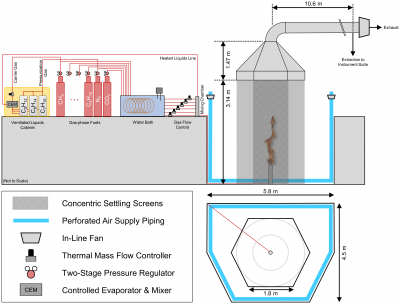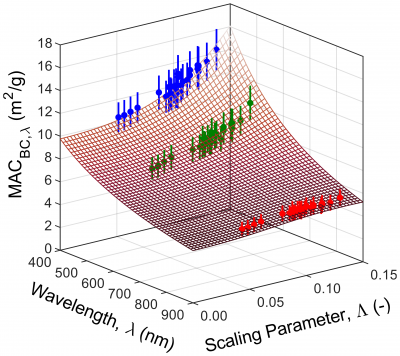The radiative forcing effect of black carbon (BC, suggested to be second only to carbon dioxide) is highly sensitive to its source location and therefore atmospheric lifetime. For example, BC emitted in the Amazon rainforest is likely to be quickly rained out of the atmosphere while wintertime BC emitted in the Siberian Arctic is thought to move poleward and deposit on the snow and ice pack, reducing the ground albedo and enhancing its rate of melt. One relevant source of BC in both of these examples is gas flaring in the oil and gas industry, the practice of combustion-based disposal of unwanted gases that are deemed uneconomical to preserve for market. Global flaring activities are large in scale with significant potential to negatively impact earth’s climate, and BC emissions from gas flares are poorly characterized relative to other important sources like diesel engines.
The simplest link between the climatic effect of BC and its atmospheric concentration is the mass-normalized absorption cross-section (MAC) of the BC particles. Consequently, BC MAC has been, and remains, a highly active topic of research. Perhaps the most well-known and well-cited data is from Bond & Bergstrom (2006) who performed an exhaustive literature review of BC MAC in the literature. They noted that variability in BC MAC tends to be overshadowed by measurement uncertainty, leading them to suggest a single value of BC MAC, despite the multitude of BC sources that exist. Their value of 7.5 m2/g at 550 nm has been cited hundreds of times. In 2016 however, researchers from Prof. Bond’s laboratory measured flare-specific BC MAC values that averaged approximately a factor of two higher than 7.5 m2/g, although uncertainties were large. These measurements raised the question of whether Bond & Bergstrom’s BC MAC should be expected to be representative of gas flaring; especially since gas flares are significantly different from other BC sources in terms of fuel and scale.

Schematic of the Carleton Vertical Flare Facility, where flares of up to three meters in length burning fuels representative of the oil and gas industry are studied.
Recently, at the Carleton Vertical Flare Facility, Ph.D. candidate Bradley Conrad and Prof. Matthew Johnson – with the help of Natural Resources Canada’s Melina Jefferson and Brian Crosland – performed the first controlled experiments of BC MAC from flames representative of gas flares in terms of fuel and aerodynamics. Flares of up to three meters in length were created burning fuels representative of the flared gases in the global oil and gas industry. Parallel measurements of BC light absorption and mass concentration enabled the direct calculation of flare BC MAC with robustly characterized uncertainties.
EERL-measured values of flare BC MAC were found to vary with fuel composition and flow rate and, over the experimental range, were as much as 30% greater than Bond and Bergstrom’s BC MAC value. Importantly, observed variability was found to be predictable via a novel “MAC scaling parameter” that captures flame radiative effects and, thus, the time-temperature history of BC while it is within the flame. The MAC scaling parameter was used to develop a phenomenological model of BC MAC as a function of readily available flare data, which could be of use to the climate modelling community.

Phenomenological model of flare BC MAC as a function of wavelength and MAC scaling parameter. Blue, green, and red data points (with 95% confidence intervals) correspond to measurements at 405, 532, and 870 nm.
The derived BC MAC model also appeared to bridge the gap between the disparate data of Bond & Bergstrom (2006) and their more recent flare-specific data. Encouragingly, the BC MAC model asymptotically approaches a value of 7.25 m2/g at 550 nm at low values of the scaling parameter that represent small-scale flames burning heavy fuels (consistent with Bond & Bergstrom’s source data). At the extreme of large scaling parameters however (large-scale flames burning lighter fuels – i.e., flares), allowing for some extrapolation, the BC MAC model reconciles Bond’s laboratory’s relatively high field measurements of BC MAC, suggesting that their results were simply a consequence of BC MAC from larger-scale flames. If the BC MAC model is indeed representative of gas flaring in the global oil and gas industry, it is possible that flare BC MAC is more than 30-100% larger than the value of Bond and Bergstrom (2006).
These observations have recently been published in Carbon and shared with stakeholders from the World Bank Global Gas Flaring Reduction Partnership (who presented these results at COP24 in Katowice) and the International Institute for Applied Systems Analysis.
Publication
B.M. Conrad, M.R. Johnson (2019) Mass absorption cross-section of flare-generated black carbon: variability, predictive model, and implications, Carbon, 149: 760-771 (doi: 10.1016/j.carbon.2019.04.086)